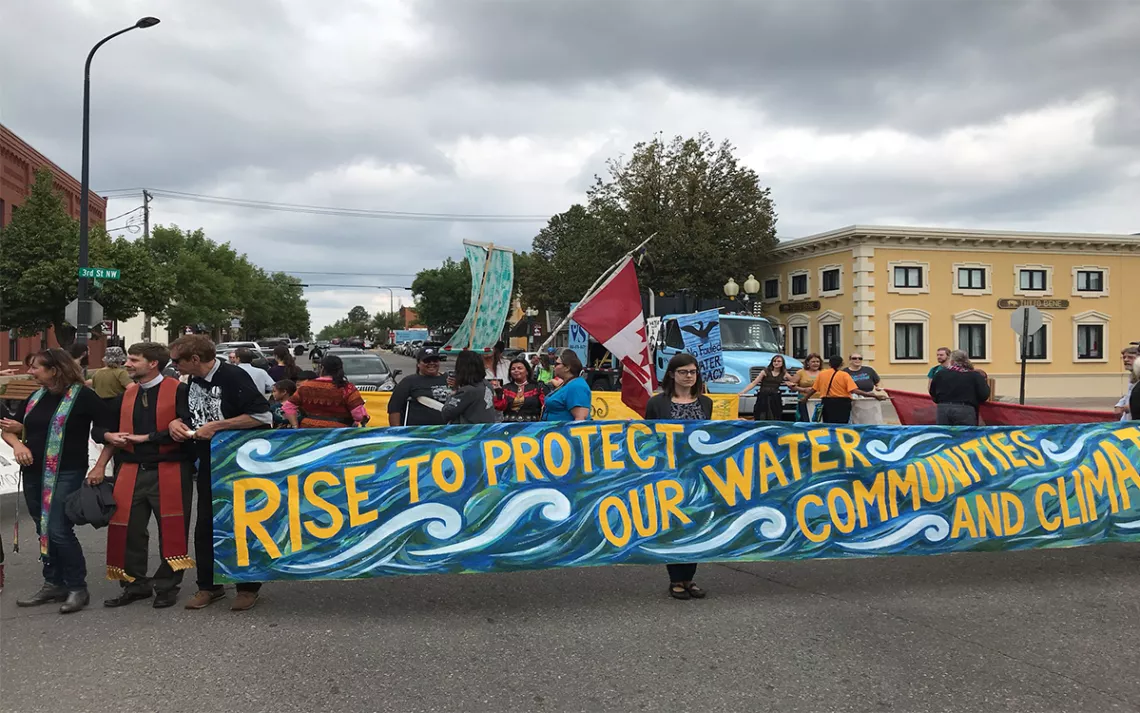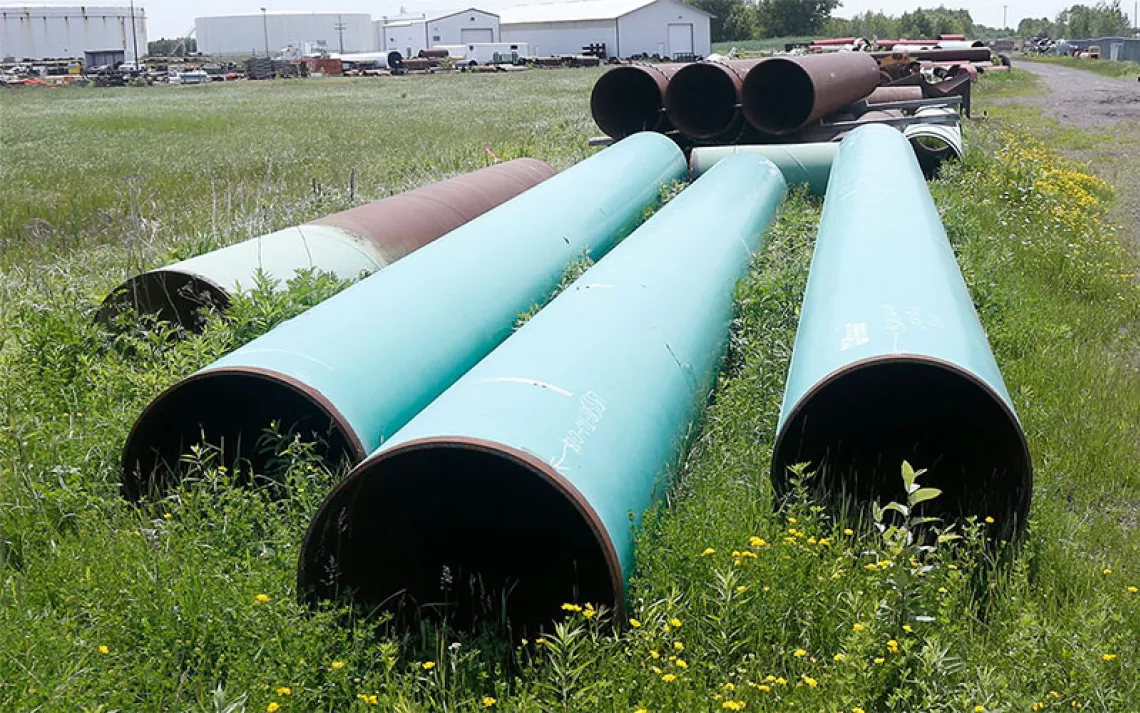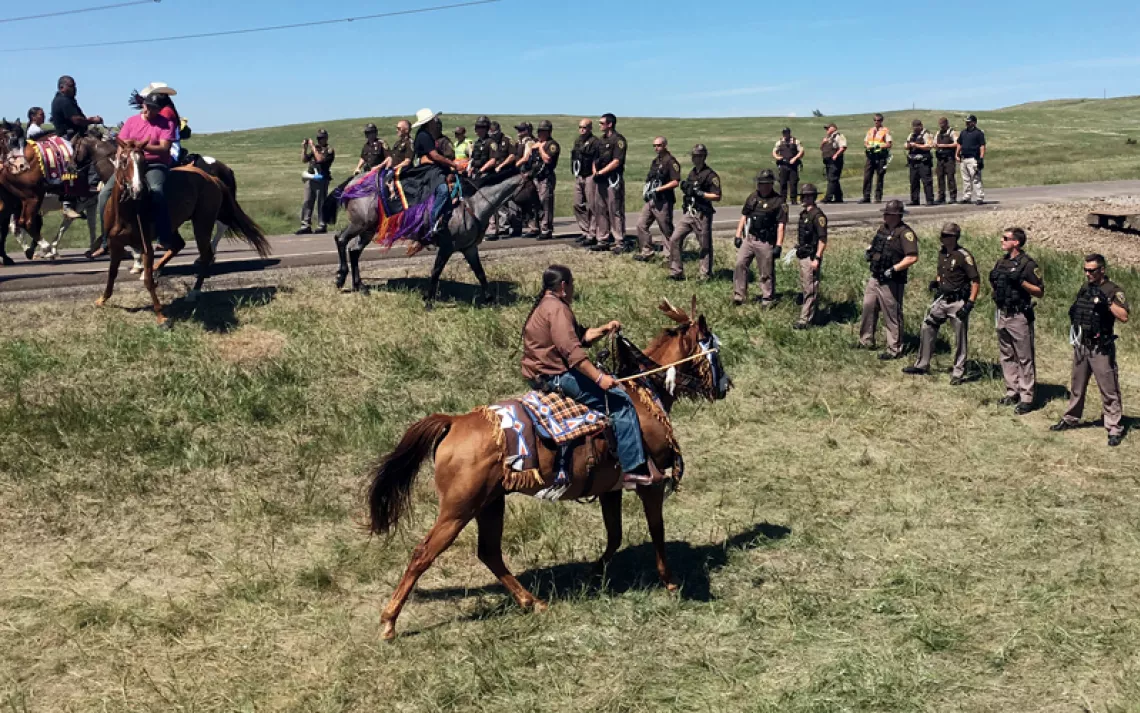Water Protectors Stage Civil Disobedience Against Tar Sands Pipeline
Protesters engage in day of action opposed to Enbridge’s Line 3

Photo courtesy of the Sierra Club
Indigenous leaders in Bemidji, Minnesota, joined with environmental activists and faith leaders to stage an act of civil disobedience Wednesday against a recently approved pipeline that will carry tar sands crude oil from Canada to the United States.
Canadian pipeline owner Enbridge recently won approval from Minnesota state regulators to replace its corroding Line 3 oil pipeline running from Edmonton, Alberta, to Superior, Wisconsin. The 1,097-mile pipeline, originally built in 1961, has developed serious structural issues, threatening wetlands in Minnesota, including tribal territory. The pipeline is currently running at half its capacity due to integrity problems.
Water protectors, faith leaders, and environmental leaders, including Winona LaDuke, executive director of Honor the Earth; Julia Frost Nerbonne, the executive director of Minnesota Interfaith Power; Kevin Whelan, the executive director of MN350; and Loren Blackford, president of the Sierra Club, locked arms in the middle of an intersection in downtown Bemidji, risking arrest to protest Line 3. At one point, protesters formed a protective circle around tribal dancers while others chanted “Water is life” and “Shut it down!”
Police closed down several city blocks around the site while protesters sat in the streets, refusing to move. At around 4:30 P.M., police made an order to disperse and announced there would be arrests if people continued to block the streets. They later detained and issued citations to LaDuke, Blackford, and others who refused to abandon the site of the protest.
"I've spent years trying to make the system work," LaDuke told Sierra after she'd been released. "And the system didn't work. The [Minnesota] Public Utilities Commission should not have issued Enbridge a permit for Line 3. Every agency opposed it. Today Loren [Blackford] and I are standing here because if they're going to try to put in this pipeline, they're going to have to arrest a lot of people."
"It was an honor to be here standing in solidarity and supporting the folks that have been fighting this for so long," Blackford told Sierra after she'd been released. "A lot of what was really moving about today was the coalition approach: indigenous leaders, faith leaders, environmental groups standing together. We're going to fight with every tool we have in the toolkit—legal work, demonstrations, actions like today—to stop this dirty tar sands oil from coming out of Canada."
The civil disobedience came as part of a coordinated day of action as other activists streamed the live feed of the protest in Minnesota governor Mark Dayton’s office in St. Paul. Speakers demanded that the governor do everything in his power to stop the pipeline project from moving forward.
Enbridge, in its application for a “certificate of need,” proposed constructing a new $2.6 billion pipeline along a separate corridor. The Minnesota Public Utilities Commission approved the proposal in June in a 5-0 decision in spite of objections from four Ojibwe tribal governments: the White Earth Band of Ojibwe, the Fond du Lac Band of Lake Superior Chippewa, the Mille Lacs Band of Ojibwe, and the Red Lake Band of Chippewa Indians. Although Enbridge's proposed pipeline route doesn’t directly cross any Native American reservations, it does slice through lands where the Ojibwe enjoy hunting, fishing, and gathering rights under treaties made with the U.S. government.
“As someone who is from Minnesota and is Ojibwe, I look at this as, here is the state shirking its duty yet again to respecting tribal sovereignty within its territory, and to having a better relationship to the tribal nations within the state,” Tara Houska of Honor the Earth told Sierra as police started moving in.
Line 3 transports one of the dirtiest fossil fuels in the world. The mining and extraction process for tar sands oil includes surface mining or injection steam, destroying surrounding land, spreading toxic metals, and threatening the world’s largest boreal forest. Extracting a single gallon of oil from tar sands produces as much as three times the greenhouse gas pollution as a conventional gallon, as well as 15 percent more carbon dioxide, one of the primary contributors to global warming. A 2016 report published in Nature found that the Alberta tar sands industry is also one of the biggest sources of toxic air pollutants in North America.
The new Line 3 route will cross some of the most pristine water resources in Minnesota, posing a grave threat to lakes and rivers, as well as wild rice waters, from oil spills.
Margaret Levin, director of the Sierra Club North Star Chapter, told Sierra from the protest site at Bemidji that the fight is not over. “We’re seeing a new level of understanding and deep concern over both the risks that pipeline projects like these pose to clean water and the costs of disrespecting and dishonoring Indigenous treaty and cultural rights,” she said.
“Committing to fossil fuel projects like these commits us to decades of tar sands oil when what we need is a transition to clean energy and to protect our climate for future generations,” she said. Levin was arrested later in the day.
Honor the Earth and Friends of the Headwaters recently asked the Minnesota Court of Appeals to declare the final environmental impact statement on Line 3 invalid, calling the review process “contrary to law, not supported by the evidence, and arbitrary and capricious.” The groups claimed that the PUC ignored tribal concerns in its review of the proposal as well as evidence of the significant risk of oil spills along the pipeline route.
Tara Houska also points out that Enbridge's certificate of need can be appealed and there are still 29 remaining state permits Enbridge will need, held by the state's Pollution Control Agency and the Department of Natural Resources, before the pipeline can proceed.
"So there is still an enormous amount of pressure that can be exerted on the governor before he leaves office, and on incoming candidates" Houska said. "We're trying to keep the public aware of what's happening as much as possible so that we don't get to the point of what happened at Standing Rock, with the bulldozers arriving and people getting hurt."
This article has been updated since publication.
 The Magazine of The Sierra Club
The Magazine of The Sierra Club



